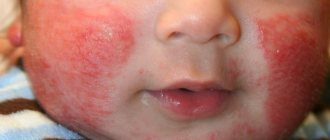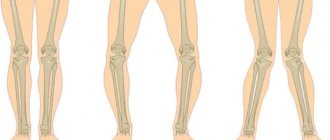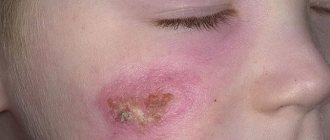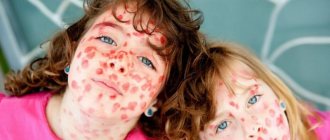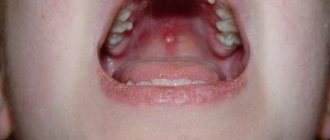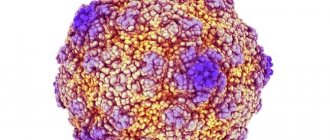Causes of exanthema
There are several reasons that cause exanthema in a child:
- viral infections most often provoke the appearance of characteristic skin rashes (flu, enterovirus infection, childhood quarantine diseases, etc.);
- bacterial infections - bacteria provoke symptoms of this pathology in children much less often than viruses; In this case, children who are often ill or have signs of severe immunodeficiency are most susceptible to the development of infectious exanthema;
- parasitic diseases - parasites rarely cause illness; the toxic effect of their metabolic products on the child’s body causes a disruption in the proper functioning of the immune system;
- excessive tendency to allergic reactions - often the result of impaired functioning of the immune system;
- various immune reactions (immune complex, cytotoxic and autoimmune) that occur when a child has hypersensitivity or defects in the functioning of the immune system.
Preventive actions
Prevention of exanthema is not necessary, because It occurs once, after which immunity is developed, and the baby subsequently does not suffer from this disease. General recommendations are to improve the health and hardening of the baby to strengthen the immune system, which will allow him to resist various infections and viruses, and if an illness occurs, to recover quickly.
You should also protect your child from communicating with peers if they have been diagnosed with exanthema. Breastfed children tolerate roseola much more easily. Parents need to be vigilant towards their child, and if they suspect exanthema, immediately seek help from a doctor.
Types of exanthema
There are three types of exanthema in children: sudden, viral and enteroviral (as a subtype of viral).
Sudden exanthema
This pathology means a disease of viral origin, which mainly develops in young children and is always accompanied by high body temperature, after which a widespread rubella-like rash occurs. In adults, sudden exanthema does not occur. Pediatricians and infectious disease specialists call it infantile roseola or three-day fever.
The main causative agent is the herpes virus. The average incubation period is ten days. Initial manifestations always develop acutely against the background of complete well-being and are characterized by a strong increase in temperature, enlargement of the occipital and cervical lymph nodes, swelling of the upper eyelids, runny nose, diarrhea, irritability, hyperemia (redness) and swelling of the conjunctiva of the eyes.
The characteristic elements of the rash are detected on the second day after the onset of fever, and an improvement in the baby’s general condition is noted. The rashes are pink in color and do not exceed 2 - 3 mm in diameter. As a rule, they are localized on the face and upper half of the body, but in some cases widespread skin lesions can be observed. A specific sign of sudden exanthema is the absence of itching and the disappearance of elements of the rash when pressure is applied.
Viral exanthema
It is the most common variant of this pathological condition, the maximum importance in establishing which should be given to the presence of contact of the child with a sick person, as well as the local epidemiological situation. In winter, the development of viral exanthema is often facilitated by influenza pathogens, adenovirus, rhinovirus infections, etc. In summer, it is often caused by enterovirus infection entering the body. Also, at any time, vesicular exanthema may occur, which is caused by a herpetic infection.
Viral exanthema is distinguished by a variety of symptoms that directly depend on the pathogen. For example, a respiratory virus is characterized by the appearance of pink spots that tend to merge with each other and rise above the surface of the skin. If an itchy rash is accompanied by keratoconjunctivitis, it is worth suspecting the adenoviral nature of the disease.
Viral exanthema has a fairly favorable course, as well as a tendency to self-heal. Most often, it is accompanied by a reaction from the local lymph nodes: an increase in size and painlessness on palpation (palpation). In rare cases, newborns experience tension in the large fontanel, the appearance of convulsive readiness and other neurological symptoms indicating an infectious lesion of the brain.
Some children have a specific “fishing net” rash, which is localized on the cheeks and is caused by parvovirus. In some patients, such exanthema occurs latently (hidden). The average duration of its course is four days. A characteristic symptom is an increase in the intensity of the rash when the skin is exposed to sunlight, hot water, emotional and physical stress.
In adults, viral exanthema in some cases may be accompanied by the development of arthralgia (joint pain) with predominantly damage to large joints, which significantly worsens the patient’s condition. Its duration sometimes reaches several months.
Enteroviral exanthema
This form of the disease is characterized by an acute onset of clinical manifestations as an increase in temperature over 39°C and increasing intoxication, after which diffuse rashes develop without a specific localization. As a rule, the nature of enteroviral exanthema is morbilliform, but some patients may experience a petechial (pinpoint) rash that disappears after four days.
A characteristic feature of this form of pathology is its possible development against the background of ongoing fever. A peculiar variant of the course is infectious exanthema, which affects the skin of the hands and feet, as well as the oral mucosa. It occurs with moderate symptoms of intoxication and a slight increase in temperature.
The vesicular type of enteroviral exanthema is most often localized on the phalanges of the hands and feet; the elements of the rash do not exceed 1 - 3 mm in diameter and are characterized by the presence of a hyperemic (red) corolla.
There are also several forms of exanthema:
- mild - the temperature rises slightly and returns to normal fairly quickly, and the rash is not spread over the entire body;
- medium - the temperature does not rise above 38°C, while the rash covers the entire body; after taking medications, the patient’s condition returns to normal;
- severe - the temperature rises to 39 - 40°C, the elements of the rash have a bright shade and cover the entire body; It is impossible to normalize the condition without medication, and severe fever can even pose a threat to the patient’s life.
Pathogenesis
The following pathogenetic mechanisms are distinguished in the development of viral exanthema:
- Various viruses enter the skin through the bloodstream and cause tissue damage.
- Activation of the body's immune defense factors.
- Interaction of pathogens with immune factors (humoral and cellular) and the production of pro-inflammatory cytokines. This mechanism causes the rash to appear.
- Viremia stimulates the formation of neutralizing antibodies (IgM), which ultimately leads to its cessation.
The basis for the appearance of any rash is inflammation. The virus has an initial effect on the blood vessels of the skin, the damage of which is manifested by hyperemia. Then an inflammatory reaction in the form of erythema develops around the vessels. More pronounced inflammation is manifested by various exudative rashes. In some cases, circulating immune factors themselves, without the presence of pathogens, can cause rashes (fulminant purpura, acute urticaria, Stephen Jones syndrome).
Epidemiology
Viral infections with exanthema are caused by various viruses and some of them are precisely defined:
- The sixth disease is associated with herpes viruses types 6 and 7. It manifests itself as roseola in children, and in adults as chronic fatigue syndrome, which is associated with the persistence of the virus. It occurs in children under 3 years of age, with a peak incidence from 7 to 13 months. Most children are seropositive at birth (that is, they have maternal antibodies), but their titer decreases by 5 months. Type 6 HHV is characterized by the ability to persist and remain in the infected person’s body in a latent state without manifestation of the disease. Some scientists associate multiple sclerosis, pityriasis rosea, and thrombocytopenic purpura with the effects of this virus, but such statements are controversial.
- The measles virus causes the corresponding disease.
- Parvovirus B19 - Chamer's erythema or burning cheeks disease. Itching with this disease is moderate.
- Boston exanthema is an infection caused by the ECHO 9.16 virus, less commonly by Coxsackie virus. For the first time in 1951 in Boston during an epidemic, the causative agent of this infection was described and studied.
- Coxsackieviruses A and B and ECHO are associated with hand-foot-mouth disease.
- Other enteroviral exanthemas are associated with infection with Coxsackie viruses A10, A16 and enterovirus type 71.
The source of infection is the patient and the virus carrier (for enterovirus infection). The patient sheds the measles virus during the last 2 days of the incubation period until the 4th day of the rash. Individuals who have not been vaccinated and have not had measles are highly susceptible to the virus and can become ill during their lifetime at any age. The same applies to enterovirus infections, which are caused by different serotypes of viruses, then immunity is developed only to a given serotype of the virus (type-specific). This means that the next time a person may become ill with an enterovirus infection caused by another type of virus currently circulating in nature. A person who has been ill sheds the virus in their stool for several weeks.
Virus infection occurs in various ways:
- Airborne. Characteristic of the sixth disease, measles, rubella. In the sixth disease, the virus infects the salivary glands and is released along with saliva. The gateway to infection in the case of airborne transmission is the mucous membrane of the respiratory tract. In the mucosal epithelium, the virus multiplies, spreads hematogenously and becomes fixed in organs. From the last days of incubation and the first days of the appearance of the rash, the virus is released from the blood, so transmission of infection (including the sixth disease) is possible through blood obtained from the patient during this period.
- Fecal-oral - more typical for enteroviruses that cause Boston exanthema, hand-foot-mouth disease. Enteroviruses are ubiquitous and remain in the environment for a long time (water, soil, household items, food) because they are resistant to chemical and thermal factors. They penetrate the mucous membrane of the gastrointestinal tract, multiply in the lymph nodes, and after 2-3 days they enter the blood (viremia) - this is the period that is accompanied by the appearance of a rash. For these infections, an airborne transmission mechanism cannot be ruled out.
- The incubation time for infections is different: for enterovirus infections it is 3–8 days, for measles it is slightly longer – 6–21 days, for rubella – 16–20 days. All infections are characterized by an acute onset, fever, sore throat, muscle pain and diarrhea (for some diseases).
What does exanthema look like in children?
The appearance of a skin rash in children is preceded by an incubation period. Usually it is approximately 7 - 10 days. As a rule, at this time the child has no symptoms of the disease. After the end of this period , the temperature rises significantly, which can reach 38 - 39 degrees.
Against the background of severe fever, the baby usually develops severe chills. He becomes whiny, excitable, and has poor contact even with his closest relatives. In addition, appetite also suffers. During the acute period of the disease, children refuse to eat , however, they may beg for “sweets.”
There is also an enlargement of the lymph nodes, most often the cervical ones; they adhere to the skin and become dense and painful when palpated. The child develops a mucous, watery runny nose and severe nasal congestion . The eyelids swell, the facial expression takes on a painful and gloomy appearance. When examining the pharynx, is noted .
A couple of days after the child’s temperature rises, a characteristic rash appears. It has no particular localization and can occur in almost all parts of the body. The rashes practically do not merge with each other and are located at some distance from each other. They usually persist for 1 to 3 days and then disappear on their own. As a rule, there are no traces or residual effects on the skin.
Exanthema occurs much more easily in children under three years of age than in older children. The most severe course of this disease is considered to be in adolescents.
Symptoms and course of the disease
- Bed rest for febrile syndrome.
- Walking after the temperature drops. The rash is not a contraindication to being in the fresh air. You can walk as much as you like. At the same time, you should avoid visiting crowded places.
- Drink plenty of fluids. It can be fruit drinks, compote, herbal tea. The liquid accelerates the removal of toxins from the baby’s body, thereby speeding up the healing process.
It is not advisable to bathe children at high temperatures. Only wiping with cool water is recommended to reduce the temperature. When the child’s well-being has stabilized and only a rash remains from the illness, water procedures are allowed. When bathing, it is recommended to use neutral baby soap, but it is better to avoid bath salts and washcloths.
The body is covered with reddish patterns, similar to lace. The latent phase of the disease lasts up to fourteen days. Sometimes, a couple of days before the rash, the temperature rises slightly, there is a headache, weakness, the urge to vomit, and the mucous membrane of the respiratory tract becomes inflamed.
First, the rash covers the face in spots. Soon they unite into solid red areas on the surface of the cheeks.
After four days, the face clears up, but the neck, torso and folds of the arms and legs are strewn with spots with rounded edges and nodules of different shades of red. The rash is lighter in the center, so it looks like a lace mesh.
Sometimes it sprinkles on my palms and feet too. The skin itches. With manifestations on the epidermis, the patient’s infectiousness disappears. The rash goes away in about ten days, leaving no traces. The influence of ultraviolet radiation, hot water, low temperatures, overexertion and anxiety can delay recovery.
Features of exanthema in newborns
In newborn children, specific clinical signs of exanthema often appear. The occurrence of a skin rash in a baby often confuses parents. The appearance of a high body temperature makes him think about the presence of a viral infection. This leads to frightened parents urgently calling a doctor to their home. As a rule, in this case, a viral infection is diagnosed and appropriate treatment is applied, which, unfortunately, does not save the baby from developing skin rashes.
In a newborn child, infectious exanthema does not have pronounced clinical manifestations. On the 1st - 2nd day from the moment the baby develops a high fever, rashes also appear. The skin of infants is very delicate, as a result of which the rash quickly spreads throughout the body. Within a day, rash elements can be found on almost the entire body, including the face.
During periods of high temperature, the well-being of newborn children suffers slightly. Some of them may refuse breastfeeding, however, the majority continue to actively feed.
Many children, after suffering an illness, remain immune for the rest of their lives. Only in exceptional cases do repeated cases of the disease occur.
What is erythema infectiosum
Viral erythema can manifest itself as a separate disease or be part of the symptomatic manifestations of other diseases from the dermatological group.
It is considered to be a combination of several types of viruses, which manifest themselves as redness in different areas of the skin. Most often, erythema occurs in young children and newborns who have weak immunity, which does not allow them to provide adequate resistance to viral pathogens.
The disease has various clinical forms:
- Chemer's erythema is the most common form, caused by parvovirus B19;
- Leiner's annular erythema - pathogens streptococci;
- exudative erythema multiforme - it occurs during the development of infectious diseases in the body: tonsillitis, sinusitis, whooping cough and others;
- erythema nodosum - can manifest itself with the development of rheumatism, tuberculosis;
- exanthema - appears suddenly due to the development of herpes disease of various types;
- pink lichen of Zhiber;
- Rosenberg's erythema;
- streptoderma with ring-shaped erythema;
- toxic form of erythema.
In medicine, it is customary to distinguish another type of disease - physiological erythema. It is not considered a pathological phenomenon, since redness in children appears under the influence of external factors.
The manifestation makes itself felt in the first three days after the birth of the child. There is no need to treat physiological erythema - it disappears on its own without a trace within some time.
Diagnostics
In order to confirm or refute the diagnosis, the following diagnostic methods are used:
- examination of the patient - a specialist examines the child, examines the spots on his body, and also asks the parents about the onset and course of the disease;
- blood test - necessary to detect the virus in the body;
- Urinalysis also helps in establishing an accurate diagnosis.
The methods listed above are quite sufficient. As a rule, viral and enteroviral exanthema is detected during the first visit to the doctor.
Therapeutic measures
There is no specific treatment regimen for exanthema; the elements of the rash disappear on their own when the body copes with the infection on its own. It is forbidden to apply brilliant green and other antiseptic solutions to the affected areas until the child has been examined by a doctor.
If a child is diagnosed with measles or rubella, he needs bed rest, as well as the use of antipyretic drugs based on paracetamol. To prevent the addition of a bacterial infection in the presence of itching, antiallergic medications are prescribed:
- Zodak,
- Zyrtec,
- Suprastin.
In any case, drink plenty of fluids, as this will help remove toxic substances from the body.
For topical application it is recommended to use the following ointments:
- Fenistil,
- Elokom,
- La Cree.
Applying these ointments for five days will help clear up the rash.
Chickenpox is easily tolerated in the vast majority of cases; it is recommended to lubricate the elements of the rash with brilliant green or a solution of potassium permanganate.
Herpes infections are treated with an ointment called Acyclovir. In more severe cases, antiviral agents are prescribed, such as Arbidol, Anaferon.
Exanthema of enteroviral origin requires the administration of glucocorticoids for oral administration.
Breastfed babies are recommended to be put to the breast as often as possible. This need is explained by the fact that mother’s breast milk contains a large amount of antibodies that help fight the disease.
If the affected areas of the skin are dry, they can be lubricated with baby cream.
The room where the sick child is located must have cool, humidified air, otherwise the baby will sweat, which will complicate the course of the disease. Therefore, you need to ventilate the room and carry out wet cleaning as often as possible.
You can eliminate the rash using recipes from folk sources, but such treatment must be agreed with a doctor. The use of baths prepared on the basis of decoctions of medicinal plants, such as:
- chamomile,
- series,
- calendula,
- celandine.
It is recommended to add a few drops of fir oil to the bath water.
Fresh potato juice can be applied to the affected areas of the skin three times a day. To prepare it, you need to grate the potatoes on a fine grater and squeeze.
Positive dynamics are observed if you give your child teas prepared on the basis of:
- dry raspberries,
- blueberries,
- rosehip,
- black currant,
- bird cherry.
You can also use lemon balm, currant and raspberry leaves. During the treatment period, it is better for the child to avoid exposure to the open sun, as this can increase the intensity of the appearance of the rash.
Treatment of exanthema
The principles of treatment for exanthema of viral origin in children do not differ from other diseases of an infectious nature, and it is based on strict adherence to bed rest and increased fluid intake. A child’s fever, which often precedes the onset of exanthema, is an indication for the prescription of medications that lower body temperature (antipyretics) , with mandatory dosage compliance.
A characteristic feature of viral exanthema is the development of fever that is resistant to the use of antipyretic drugs. The appearance of elements of a rash in a child does not require the use of any drug correction. There is also no need to use topical treatment. Exanthema in children, as a rule, is not accompanied by itching, so there is no need to prescribe desensitizing agents.
In case of viral exanthema, it is mandatory to comply with quarantine measures, since the child remains infectious at the moment the elements of the rash appear. In the case when an infant develops an infectious exanthema, it is necessary to frequently apply it to the mother’s breast, since her milk contains a huge amount of protective antibodies.
Sudden exanthema in children, which is caused by the herpes virus, is treated by prescribing acyclovir. chickenpox is accompanied by the development , it is recommended to lubricate the elements of the rash with a solution of aniline dye, which in turn prevents the addition of a bacterial infection.
Etiology
There are many provoking factors for the occurrence of exanthema; most scientists are inclined to think that the disease can cause:
- measles virus,
- rubella,
- herpes type 6,
- Epstein-Barr virus,
- enterovirus,
- cytomegalovirus.
These pathogens lead to the appearance of neoplasms on the skin in the form of papules and spots.
The rash, which resembles blisters, is formed as a result of exposure to microorganisms of herpes type 1, the Coxsackie virus and the virus that provokes the formation of chickenpox and herpes zoster.
Adenoviruses and enteroviruses lead to the appearance of hyperemia and elements of a papulovesicular rash. Parvovirus B19 infection is characterized by the formation of a lace-shaped rash on the skin.
General information
Sudden exanthema (pseudo-rubella, roseola, three-day fever, sixth disease) is a childhood viral infection characterized by high fever and a spotty rash on the skin. Sudden exanthema affects about 30% of young children (from 6 months to 3 years). In most cases, sudden exanthema develops in a child between 9 months and 1 year of age; less often up to 5 months. It is assumed that the disease is transmitted by airborne droplets and contact. The peak of the spread of infection occurs in autumn and winter; girls and boys get sick equally. Sudden exanthema is experienced by children once, after which those who have recovered develop stable immunity.
Sudden exanthema
This is interesting: 17 best remedies for hemorrhoids - suppositories, tablets, ointments
Prevention
Specific prevention of exanthema has not yet been developed. As preventive measures, doctors recommend maintaining personal hygiene, strengthening the immune system, eating properly and nutritiously, and avoiding sick people with fever and skin rashes. Such measures significantly reduce the risk of developing illness.
In most cases, the outcome of exanthema is favorable. The disease ends with complete recovery and the acquisition of permanent immunity. There is no vaccination against skin lesions, so prevention and isolation of the patient comes first.
Pseudo-rubella: is it contagious or not to others?
The infectious period for pseudorubella lasts from the beginning of the incubation period until the temperature drops.
After the temperature has stabilized and the first rashes have appeared on the face, a person with roseola does not pose a danger to others.
The period of infectivity in adults is much longer due to the long incubation period and slow activation of the virus.
In most cases, after suffering from pseudorubella, especially in childhood, the body develops 100% immunity and there is no chance of relapse.
In exceptional cases, re-infection is possible:
- weak immune defense or immunodeficiency;
- use in the treatment of hormones that prevent the synthesis of antibodies to the roseola pathogen.
Detailed instructions for using Lipobase cream and emulsion are presented in this material.
The causes, symptoms and treatment of herpangina in children are discussed in our publication.

